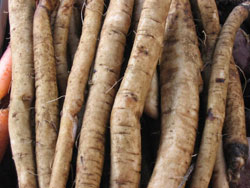For many people, burdock is associated with prickly burrs that get stuck on clothing, in hair, and of course, on pets. What is less commonly known about this plant is it’s use as both a food and medicinal crop.
Burdock is a biennial plant, meaning that it takes two years to complete its life cycle and produce seed. While some Japanese dishes use the tender leaves of the plant (which are harvested in the spring), the long tap root is the part of the plant most prized for both culinary and medicinal purposes. It is harvested in the late summer or early fall of its first growing season and can grow anywhere from 1 to 3 feet long. It is most commonly used in Asian cuisine (where it also goes by the name of Gobo) and has gained in popularity in the West as a promoted ingredient in macrobiotic diets. It has an earthy, slightly bitter flavor.
Considered in herbalism to be both an alterative and depurative, burdock is used to treat a host of maladies. Its primary applications are as a blood purifier, removing toxins and promoting kidney function. In Chinese medicine it is considered to have yin, or cooling, energy and is therefore used to treat yang, or “hot” conditions such as fever, boils and infections (American Health and Herbs 1997).
Burdock is believed to have originated in Eurasia, although it has become naturalized in other parts of the world over the past few centuries. Here in Vermont, longtime Deep Root member Cate Farm has been growing and specializing in burdock production since 1985. They were recently featured in the Barre/Montpelier (VT) Times Argus – check out the article here: https://www.timesargus.com/?s=burdock

